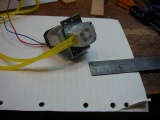 [Big]
You can see the motor, with its enclosed gearing, attached to the
plastic pump. Both are screwed to a small metal bracket. It's all
pretty well made.
[Big]
You can see the motor, with its enclosed gearing, attached to the
plastic pump. Both are screwed to a small metal bracket. It's all
pretty well made.


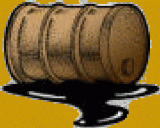
In 2000, when we got our SV650, we were about to go on a long tour. We realized we had a need for a chain oiler. We had added a centerstand, which was supposed to help ease the oiling problem (doing regular lubing on a 10,000 mile trip was going to be a nuisance), but we realized after it was installed that because the bike had been lowered, the centerstand was incredibly difficult to use -- almost impossible.
So we investigated oilers. After examining the market (which was smaller then than it is now) we chose to get a Hawkeoiler. At the time it seemed that it might be more reliable or, at least, predictable than the Scottoiler. The notion of having to push a button once in a while to lube the chain wasn't a problem. (I guess this makes the Hawkeoiler a "semi-automatic" oiler, rather than fully automatic.) I should explain my comment about the Scottoiler. If you're not familiar with it, it's "enabled" by a vacuum line from the engine, which essentially turns on a small valve while the motor is on. The system then drips at a steady (slow) rate. At the time we were purchasing, there were a fair number of reports of problems with the oiler dripping while the bike was parked, or of not dripping at a reliable rate in the face of altitude and temperature changes.
The Hawkeoiler installed pretty easily, and John "Hawke" Laurenson, the owner/designer, was very helpful with the couple of questions I did have, and even sent me some spare tubing after I stupidly lost a crucial piece. He also seemed quite concerned with quality, and held up production when it turned out his solenoid piston pump wasn't always "anti-siphoning" -- several people had slow drips while the pump was not being used. He fixed this with a check valve downstream from the pump, which only opens under pressure, and not simply with the force of gravity.
So we got a Hawkeoiler, had a great trip, and the chain lasted nicely.
So I started looking around again. First I found that the Hawkeoiler and Scottoiler have been joined by the Loobman. The Loobman is a very simple product, involving a squeeze bottle and some tubing connected in such a way that when you squeeze the bottle, oil gets delivered to the tubing where it can be gravity-fed to the chain. At least, that's how I think it works. There's a good review here and a not so good review here. One thing the Loobman does have going for it is the oil applicator, which apparently works well and delivers oil to both sides of the sprocket, and hence the chain. The Hawkeoiler, and at least the early Scottoilers, deliver to just one side, and rely on capillary action and the movement of the chain to migrate the oil to the other side. This seems to work pretty well in practice, but the designed-in symmetry of the Loobman is attractive. The price of the Loobman is also attractive.
I also just discovered a product made in Germany, the CLs200µ. This unit certainly takes the complexity award -- it automatically senses when the bike is running, using variations in the electrical system voltage as a key. The drip rate is also controlled electronically, and you get a little electric knob that controls the drip rate. Very sophisticated, and also very expensive.
None of the available solutions really impressed me in an engineering sense. Oiling a chain seems like a simple problem, and all of these products were fairly complex. The Scottoiler has a lot of extra stuff on it to make it drip right under all conditions. The Hawkeoiler is good, but the checkvalve is an unfortunate necessity, and it seems a shame to have to electrify what seems like just a mechanical problem. The Loobman is simplest, but a) I wasn't sure where I'd mount the squeeze bottle, and b) I was put off by the report of over-oiling at altitude, in the second review referenced above.
I had some parts left over from our original Hawkeoiler -- two oil reservoirs are provided with the kit, and I had some of the semi-rigid delivery tubing left over -- so I figured I'd try and make my own oiler. My first thought was to try to locate a pump identical to the one that comes with the Hawkeoiler. I found it, I think (the Clark Solutions EMX-08 piston pump), but then I realized I'd also need to find the little check valve, and that was a lot harder. [Turns out it wasn't that hard. A friend pointed me at this one from McMaster-Carr, which would almost certainly work -- thanks Vacek! -pgf 6/2014] And I'd also need all of the different sizes of tubing needed to hook things up. Pretty soon I might as well just buy the whole thing over again, and that wasn't the point. (Though I still think his is the best of the commercial oilers.)
But while searching for a solenoid piston pump, I came across another pump technology I'd never seen before. This despite being very familiar with the principle from anatomy class in high school. A peristaltic pump works by repeatedly squeezing the tubing containing the fluid to be pumped, as in this animation. You do the same thing with your fingers when working the last drop of glue or toothpaste out of a tube. A key feature of peristaltic pumps is that they are by nature anti-siphoning -- when the pump stops moving, the tubing is sealed, and the fluid can't flow past it. Peristaltic pumps are also self-priming -- they'll pump air as well as liquid, and therefore can suck liquid up to and through the pump. (They'll also pump in reverse, providing a convenient means of emptying the system back to the reservoir.)
This seemed like a good solution -- a simple, small pump, no extra valves, and (hopefully) reliable operation. My problem was finding one suitable for use on a bike. If you google for peristaltic pumps, you'll quickly learn that they're primarily used in laboratories and the food industry. Since the fluid never touches the pump itself, cleanliness is guaranteed, and maintenance is simplified. But you'll also find that peristaltic pumps aren't cheap. (The Hawkeoiler was starting to look better and better.) But then I discovered a hobbyist application -- it turns out that aquarium owners use small pumps to automatically deliver nutrients and other chemicals to their tanks. I got lucky at Automated Aquarium Systems [broken link], where they sell the pump I needed [broken link] -- namely, 12V operation, and very little volume per revolution of the pump. (This is important -- you want "drips" of oil, not "flows".) It seems those links are broken, so I can't tell you where to find my pump. The aquarium folks seem to call these things "dosing pumps", so that might help with searching.
I took a chance, and spent $75 on the smallest 12V pump they sell (the
"DP101-030-012-016"). When
it arrived, it looked like this:
 [Big]
You can see the motor, with its enclosed gearing, attached to the
plastic pump. Both are screwed to a small metal bracket. It's all
pretty well made.
[Big]
You can see the motor, with its enclosed gearing, attached to the
plastic pump. Both are screwed to a small metal bracket. It's all
pretty well made.
Glitch #1: The immediate problem I had was that the Norprene
tubing they provide with the pump
(which is not the tubing pictured here)
is provided as a good, non-toxic material, suitable for
food industry, medical, and laboratory applications. It's perfect
for an aquarium. It's not, however, suitable for carrying motor oil --
when I looked up its chemical compatibility properties, it
was listed as "unsuitable, don't use". I had visions of the tubing
rotting out and dumping oil all over my motorcycle. So I got on the
web again, and found a tubing that is suitable for carrying
oil (and also suitable for peristaltic pumping -- it has to be very
soft, and hold up well to mechanical stress).
Solution #1: I found that
Tygon Fuel and Lubricant tubing
was exactly what I needed -- soft, petroleum compatible, and resistant
to UV exposure. Not only that, but one of my favorite web merchants,
McMaster-Carr, carries it. (Search for "tygon fuel" on their page
to find it quickly.) The minimum order for the 3/16" tubing
(part no 5552K22) was 10 feet, so that's what I got. [ But see Postscript #3,
below. ] (By the way, their
catalog has the price transposed -- it's $0.57/foot, not $0.75) (Also
note -- the 1/4" tubing might be a better choice -- see Glitch #2, below.)
So I got my tubing, and started trying to figure out where to mount
the motor/pump, and where to mount the switch, and then I realized:
I didn't
need the motor! It's unlike me to shy away from anything involving
motors and buttons, but I was planning on pushing the button
once in a while
for only a second or less, resulting in just half a revolution or
so of the pump. I could do that just as easily with a knob, and eliminate
about half of the complexity and installation hassles. The motor
unit drives the pump by means of a "flatted shaft". I found a suitable
knob in (one of) my junk box(es), made a flatted shaft (by grinding a
flat on a round shaft, of course) that fit both the knob and the pump,
and I was in business:
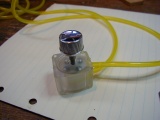 [Big]
[Big]
What I don't know is if the aquarium folks will sell the pump without
the motor. Probably not. If anyone knows of another supplier of cheap
low-volume peristaltic pumps like this one, please let me know...
Here's a picture of the pump innards, exposed so you can see the
rollers that squeeze the tubing:
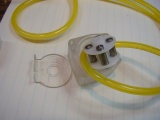 [Big]
[Big]
Glitch #2: When I stuck the end of
the tubing in a cup of water, and tried to pump it through, nothing
happened. It turns
out the 3/16" Tygon tubing isn't a match for my pump -- the rollers
don't quite pinch it shut against the inner wall, and so no pumping gets
done.
Solution #2:
I solved this by shimming the inside surface of the pump with
a thin layer of flexible plastic. This took up the excess space, and the
rollers now pump properly. The original Norprene tubing was also 3/16", like
the Tygon stuff,
but it had thicker walls. I think 1/4" O.D. Tygon tubing would fit the
pump just fine, and not require the shimming.
And here's a picture of all of the piece-parts together. As I mentioned earlier, the 2oz bottle (and its bracket) is one that came as spare with the Hawkeoiler. Great product. I recommend it. I just didn't want two of them. :-) The black delivery tubing was also left over from that installation. It's nice in that when you heat it with a heat gun or hair dryer you can bend it into position, and it will stay there when it cools down. The tubing is Parflex NR-2-026 tubing, made by Parker. You can find it under "Nylon Tubing, Series NR: Semi-rigid high strength" in the Parker catalog. I haven't found an online source, and I don't know if all "semi-rigid nylon tubing" has the nice shape-retention property. Probably does, in which case McMaster-Carr would be a good bet for this, too.
Also note that the reservoir bottle has an important feature: there's
a pinhole in the upper "shoulder" of the bottle, so that air can get
in while the oil is being pumped out.
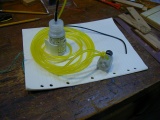 [Big]
[Big]
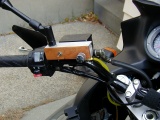 [Big]
[Big]
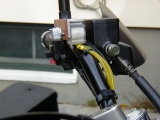 [Big]
[Big]
(The switch is for the heated grips.)
Glitch #3: When I got the pump installed, and the plumbing in place, and the oil reservoir filled up (with 90 weight gear oil, by the way), I of course immediately turned the knob to start pulling oil through the system. Just as in Glitch #2, nothing happend. I suspected my shim material, since it was cold out, and I wondered if the dimensions of the rollers and pump had changed enough for there to be no seal, once again. But that wasn't it at all. It turned out that though the knob was turning, the pump wasn't turning -- the hole in the nylon hub had been stripped out by my poorly fitted, sharp-edged homemade flatted shaft. Solution #3: Worried that I'd just ruined $75 worth of aquarium pump, I dismantled it again. I was able to rescue things by drilling a small hole through the hub and shaft, and tapping the hole for a #4-40 screw. The pump and shaft are firmly locked together now, and the pump works great.
Glitch #4: Because the tubing is being tugged on by the rollers as they go 'round and 'round, the tubing tends to "walk" through the pump. I haven't yet figured out how "professionals" deal with the problem. Solution #4: I dealt with it by zip-tying the entry and exit tubes together, and zip-tying them both to the handlebar. Not sure whether this will work long-term or not. If anyone knows a better way, do tell... The zip-ties themselves are a bit of a problem -- I used them here, and at other points, to hold the tubing to the bike's frame. but of course, they tend to pinch the tubing a bit. I'm searching for a more appropriate tubing clip, though the zip ties are fine for now.
The last few shots are not of the pump, but of the reservoir
mounting (clipped inside the V-Strom fairing's double wall), and
the business end, where the oil is delivered:
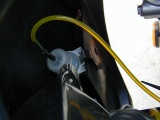 [Big]
[Big]
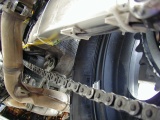 [Big]
[Big]
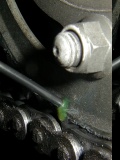 [Big]
[Big]
Sort-of-Glitch #1:
The final delivery tube delivers one drop of oil per turn of the
knob. This is as compared to the Hawkeoiler's delivery of four, or sometimes
five, drops from a single button press. This is more evidence that the
larger 1/4" tubing size from McMaster-Carr might be more appropriate.
With an I.D. of 1/8" vs. 3/32", it would move a bit more volume per pump
rotation, and require fewer overall twists.
Worry #1: I have no idea how well a pump sold for delivering food and drugs to tropical fish in a climate-controlled tank will hold up to the rigors of commuting and touring on a motorcycle in New England. The nice folks at Automated Aquarium Systems couldn't provide any temperature ratings, nor would they tell me who manufactures the pumps. Oh well -- time will tell. Calming Thought #1 At worst, I'll just break down and finally buy the Hawkeoiler. Maybe John Laurenson will take pity on me, and sell me just the pump and check valve. Probably should have asked him about that in the first place. :-)
Actually, my biggest worry right now is that the pump just doesn't move enough oil per turn of the knob. When I first tested it, I thought I was getting one drip per half revolution of the pump. But now I only seem to be getting half that -- i.e., one drip per full turn. That implies a lot of knob turning to get much oil on the chain. If that rate turns out to be right, I guess I'll definitely try the next larger size of tubing. Another possibility would be to replace the knob with a small crank, to make it a more natural motion to turn it many revolutions at once.
Alas, it didn't work so well. The trouble is, if you think about it, there's nothing keeping the oil in the U-shaped part of the double delivery head from running out -- it just siphons itself out, of one leg or the other. A single delivery tube doesn't have this problem -- there's nowhere for air to get in from the other end. So, I'm still using like the pictured head, except that one side is plugged up, and it's acting as a single-sided head. The aluminum support tube around the flexible nylon tubing is still a big help with adjusting, so I consider the reconstruction worth it even so.
One more thing -- I had ordered 10' of the original 3/16" tubing, and since there was only a little slack in the system, ordered the same amount of the new tubing. I was surprised when I barely had enough to go from one end to the other. Measuring the old stuff, it turns out they had sold me 11-1/2 feet of tubing the first time around -- maybe it was the end of a roll or something. So consider 10' as a bare minimum if you try this project.
The other thing that's changed since 2004 is that at some point I got rid of the aluminum support tube and the plexiglass block that I had added. I did, however, make a small block for the nylon delivery tube to pass through (the hole in the block is just barely big enough for the 1/8" tubing) on its way between its junction with the Tygon and the rear sprocket. That block is anchored securely to the swingarm. This gives a solid base from which to do adjustments of the delivery end, and I haven't had to readjust the nylon delivery tube in a couple of years now.